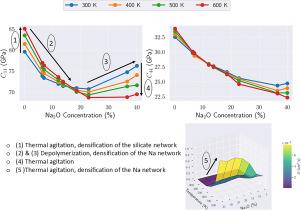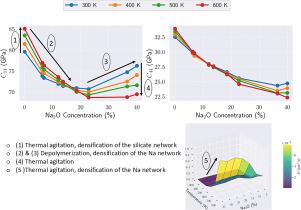The influence of sodium oxide and temperature on the atomic structure and mechanical properties of silicate glasses: A molecular dynamics and Brillouin light scattering study
IF 9.3
1区 材料科学
Q1 MATERIALS SCIENCE, MULTIDISCIPLINARY
引用次数: 0
Abstract
This study investigates the structural and mechanical properties of sodium silicate glasses (Na2O-SiO2) based on Na2O content (5–35 mol%) and temperature (300–600 K) using Brillouin Light Scattering (BLS) spectroscopy and Molecular Dynamics (MD) simulations. Key structural parameters are examined to understand how composition, temperature, and network structure interact. The results reveal significant network depolymerization as the Na2O content increases, driven by Na-rich clusters that depend on the amount of Na2O. Na diffusion is also studied and connected to its Voronoi volume. At low Na2O, Na atoms are associated with larger Voronoi volumes, making diffusion easier due to thermal agitation and densification of the silicate network. At high Na2O, Na atoms occupy smaller Voronoi volumes, requiring more energy to diffuse due to congestion of the Na sub-network and rigidification. Elastic constants (, ) show different patterns: decreases below 20% Na2O but increases at higher concentrations due to depolymerization and densification of the Na network, while steadily decreases, showing less resistance to shear due to the increasing presence of non-bridging oxygens (NBOs) (with only a minor contribution from free oxygens, FOs, whose concentration remains very low, 0.6%). Experimental results also show that at low Na2O (11%–12% for , 15% for ), elastic constants increase with temperature due to local structural rearrangements and densification effects, while at higher Na2O content, they decrease because of thermal softening driven by enhanced Na mobility and disruption of the silicate network. MD simulations confirm these trends with Na2O content and the same trends at high Na2O with temperature. However, at low Na2O, the elastic constants decrease slightly with temperature. Young’s modulus, shear modulus, bulk modulus, and Poisson’s ratio are determined from and . Novel metrics related to oxygen types and (where is the number of bridging oxygens) are suggested to connect structural and mechanical findings, showing how they relate to either or . The study highlights the competing mechanisms of thermal agitation, densification, depolymerization, congestion, and rigidification that collectively dictate the structural and mechanical behavior of sodium silicate glasses.


氧化钠和温度对硅酸盐玻璃原子结构和力学性能的影响:分子动力学和布里渊光散射研究
基于Na2O含量(5-35 mol%)和温度(300-600 K),利用布里渊光散射(BLS)光谱和分子动力学(MD)模拟研究了硅酸钠玻璃(na20 - sio2)的结构和力学性能。关键的结构参数检查,以了解如何组成,温度和网络结构相互作用。结果表明,随着Na2O含量的增加,由依赖于Na2O含量的富na簇驱动的网络解聚作用显著。还研究了Na扩散并将其与Voronoi体积联系起来。在低Na2O下,Na原子与较大的Voronoi体积相关联,由于热搅拌和硅酸盐网络的致密化,使得扩散更容易。在高Na2O条件下,Na原子占据较小的Voronoi体积,由于Na子网络的堵塞和硬化,需要更多的能量来扩散。弹性常数(C11C11, C44C44)表现出不同的模式:C11C11在20% Na2O以下下降,但在较高浓度下由于Na网络的解聚和致密化而增加,而C44C44则稳步下降,由于非桥接氧(NBOs)的增加而表现出较小的抗剪切能力(自由氧,FOs的贡献很小,其浓度仍然很低,为~ ~ 0.6%)。实验结果还表明,在低Na2O条件下(C11C11 <<11% ~ 12%, C44C44 <<15%),由于局部结构重排和致密化效应,弹性常数随温度升高而升高,而在Na2O含量较高时,由于na++迁移率增强和硅酸盐网络破坏导致热软化,弹性常数降低。MD模拟证实了这些趋势与Na2O含量有关,并且在高Na2O温度下也有相同的趋势。而在低Na2O条件下,弹性常数随温度的升高略有降低。杨氏模量、剪切模量、体积模量和泊松比由C11C11和C44C44测定。与氧类型和QiQi(其中ii是桥接氧的数量)相关的新指标被建议将结构和力学结果联系起来,显示它们与C11C11或C44C44的关系。该研究强调了热搅拌、致密化、解聚、堵塞和固化等相互竞争的机制,这些机制共同决定了硅酸钠玻璃的结构和机械行为。
本文章由计算机程序翻译,如有差异,请以英文原文为准。
求助全文
约1分钟内获得全文
求助全文
来源期刊

Acta Materialia
工程技术-材料科学:综合
CiteScore
16.10
自引率
8.50%
发文量
801
审稿时长
53 days
期刊介绍:
Acta Materialia serves as a platform for publishing full-length, original papers and commissioned overviews that contribute to a profound understanding of the correlation between the processing, structure, and properties of inorganic materials. The journal seeks papers with high impact potential or those that significantly propel the field forward. The scope includes the atomic and molecular arrangements, chemical and electronic structures, and microstructure of materials, focusing on their mechanical or functional behavior across all length scales, including nanostructures.
 求助内容:
求助内容: 应助结果提醒方式:
应助结果提醒方式:


